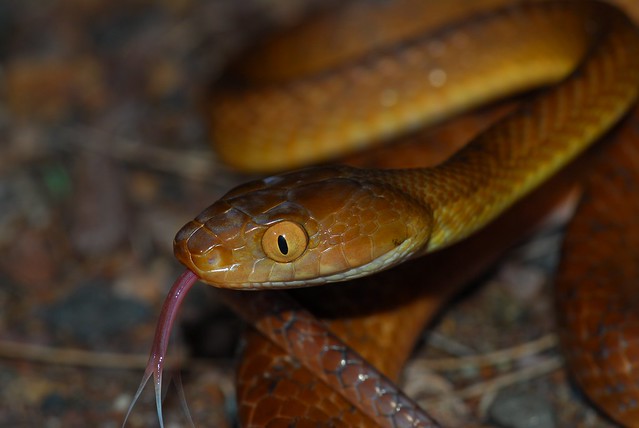Post by Ceratodromeus on Jun 8, 2015 21:40:27 GMT 5

Scientific classification
Kingdom: Animalia
Phylum: Chordata
Class: Reptilia
Order: Squamata
Suborder: Serpentes
Family: Colubridae
Genus: Boiga
Species: B. irregularis
Description:
The brown tree snake is a rear-fanged venomous colubrid. They are largely arboreal, spending alot of their days foraging in trees; B. irregularis is a very thin snake consequently. The standard coloration is a reddish-brown, with shades of white and black being distributed unevenly over the snake's total length, and coloration varies within the geographic distribution of the species. The Tail makes up ~21% of the snakes total body length. The brown tree snake's head is rather large in proportion with the rest of its body, The Brown an elliptical pupil characteristic of both its genusand most other nocturnal snakes, but it lacks the reflective layer in the retina possessed
by some nocturnal snakes to enhance vision in dim light.{1} The species is sexually dimorphic, with the males tending to be larger then the females. Total body length varies with the distribution of the species. ~2 meter(6.5ft) individuals are not uncommon on Guam, where they are an invasive species, but in other parts of their range they max out at roughly 1.8 meters(5.9ft). The largest individual recorded was a 3.1 meter(10.1ft) male, captured on Guam.{2}
Geographic range:
The brown tree snake is native to Northeastern Australia, Papau New Guinea, and various small islands in northwestern Melanesia. They have been introduced into various western Countries, but only have a substantial, healthy, breeding population in Guam.

Venom:
B. irregularis is a rear-fanged Opisthoglyphic colubrid. It's venom is neurotoxi, causing paralysis in the animal it has bitten. Neonate(newly hatched) animals have venom that is more toxic, suggesting an ontogenic shift in venom.{3}
Venom yields for four size classes of Boiga irregularis:
| Size class (N) | Snout-to-vent lengths (mm) | Snake mass (g) | Venom volume (ml) | Venom mass (g) | % protein |
| Neonate | 461.4 +/- 102.7 | 16.0 +/- .5 | 20.6+/- 5.0 | 0.7+/- 0.19 | 47.5+/- 5.7 |
| Juvenile | 909.0 +/- 130.6 | 102.7+/- 45.4 | 92.2+/- 47.7 | 2.2 +/- 0.14 | 74.9+/- 3.2 |
| Adult | 1200.9 +/- 97.4 | 284.6+/- 67.4 | 204.4+/- 89.7 | 10.2+/- 6.8 | 80.5+/- 8.1 |
| Large adult | 1844.8+/- 232.8 | 1166.7+/- 319.2 | 517.5+/- 184.1 | 19.2+/- 3.0 | 90.2+/- 15.4 |
Dietary habits:
Lizards, birds, and small mammals make up the entirety of this snake's diet. Lizards and their eggs have been found to be far more(upwards of 62% of dietary intake on Guam){4} abundant in B. irregularis' diet then birds and mammals.As a result of it's sucess introduction to Guam, there has been well documented decline in native bird and lizard species, driving several bird species to extinction.{5,6} On Guam, they are noted pests around human settlements as they frequently prey on domestic poultry.{7}

Reproduction:
Size at sexual maturity depends on locale. On Guam, males matured at a length of 1,652mm(5.4ft) and a mass of 523 g, and females matured at a length of 1,366mm(4.4ft) and a mass of 230g. In their native range, B. irregularis matures at a length of 1,012mm(3.3ft) and females at a length of 926mm(3ft).{8}Mating occurs throughout the year, with Typical clutch size ranges from 2-9 eggs, and is dependent on the size of the female. Incubation lasts roughly 90 days, and the young must fend for themselves as soon as they hatch.
References:
{1} Rodda, Gordon H., et al. "An Overview of the Biology of the Brown Treesnake*(Boiga irregularis), a Costly Introduced Pest on Pacific Islands." (1999).
{2} Rodda, Gordon H., and Julie A. Savidge. "Biology and Impacts of Pacific Island Invasive Species. 2. Boiga irregularis, the Brown Tree Snake (Reptilia: Colubridae) 1." Pacific Science 61.3 (2007): 307-324.
{3} Mackessy, Stephen P., et al. "Venom of the Brown Treesnake, Boiga irregularis: ontogenetic shifts and taxa-specific toxicity." Toxicon 47.5 (2006): 537-548.
{4} Savidge, Julie A. "Food habits of Boiga irregularis, an introduced predator on Guam." Journal of Herpetology (1988): 275-282.
{5} Wiles, Gary J., et al. "Impacts of the brown tree snake: patterns of decline and species persistence in Guam's avifauna." Conservation Biology 17.5 (2003): 1350-1360.
{6} Savidge, Julie A. "Extinction of an island forest avifauna by an introduced snake." Ecology 68.3 (1987): 660-668.
{7} Fritts, Thomas H., and Michael J. McCoid. "Predation by the brown tree snake, Boiga irregularis, on poultry and other domesticated animals in Guam." Snake 23 (1991): 75-80.
{8} Savidge, Julie A., Fiona J. Qualls, and Gordon H. Rodda. "Reproductive Biology of the Brown Tree Snake, Boiga irregularis (Reptilia: Colubridae), during Colonization of Guam and Comparison with That in Their Native Range 1." Pacific Science 61.2 (2007): 191-199.


